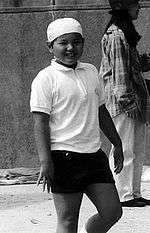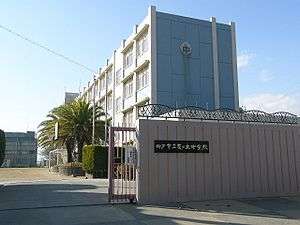Kobe child murders
| Kobe child murders | |
|---|---|
|
Tomogaoka Junior High School, where one murder was committed. | |
| Date |
March 16, 1997 (first murder) - June 28, 1997 (arrest) |
Attack type | assault, beheading |
| Weapons | hammer, handsaw |
| Deaths | 2 |
Non-fatal injuries | >2 |
| Victim |
Ayaka Yamashita Jun Hase |
| Perpetrator | "Boy A" AKA Seito Sakakibara |
The Kobe child murders (神戸連続児童殺傷事件 Kōbe renzoku jidō sasshō jiken) occurred in Kobe, Japan on March 16 and May 27, 1997. Two victims, Ayaka Yamashita (山下彩花 Yamashita Ayaka), age 10, and Jun Hase (土師 淳 Hase Jun), age 11, were murdered by a 14-year-old boy under the alias Seito Sakakibara (酒鬼薔薇 聖斗 Sakakibara Seito). The perpetrator was arrested on June 28, 1997 in connection with the Hase murder, and later confessed to both murders. As a juvenile offender, he was prosecuted and convicted as "Boy A." His real name has not been released to the press because Japanese law prohibits publishing the identification. But, in some weekly magazines, his real name has been reported. Beginning in 2004, "Boy A" was released on a provisional basis, with a full release announced to follow on January 1, 2005. The murders and subsequent release of the perpetrator gained widespread attention from Japanese media and politicians.
The murders

On May 27, 1997, the head of Jun Hase (土師 淳), a special education pupil at Tainohata Elementary School, was found in front of the school gate hours before pupils arrived for classes. Hase had been beheaded with a handsaw, with further mutilations being done before being left in front of the school, for students to discover when they arrived in the morning.[1] A note, written in red pen, was found stuffed in his mouth, identifying the killer as "Sakakibara." The note read:
"This is the beginning of the game... Try to stop me if you can you stupid police... I desperately want to see people die, it is a thrill for me to commit murder. A bloody judgment is needed for my years of great bitterness."[notes 1]
Additionally, some English was on the note as well: "shooll [sic] kill".
Police commented that the style of Hase's killing and the note was reminiscent of that of the Zodiac murders in the San Francisco area during the late 1960s.
On June 6, a letter was sent to the newspaper Kobe Shinbun, in which Sakakibara claimed responsibility for the slaying and decapitation of Jun Hase, and threatened that more killings would follow. This second letter, delivered in a brown envelope postmarked June 3, had no return address or name. Enclosed was a three-page, 1400-word letter, also written in red ink, which included a six-character name that can be pronounced as "Sakakibara Seito". The same characters, which mean alcohol, devil, rose, saint and fight, were used in the first message that was inserted into the boy's mouth.
Beginning with the phrase "Now, it's the beginning of a game", the letter stated that "I am putting my life at stake for the sake of this game... If I'm caught, I'll probably be hanged... police should be angrier and more tenacious in pursuing me.... It's only when I kill that I am liberated from the constant hatred that I suffer and that I am able to attain peace. It is only when I give pain to people that I can ease my own pain." The letter also lashed out against the Japanese educational system, calling it "compulsory education that formed me, an invisible person."[2]
In the initial panic, the Japanese media misreported the name as "Onibara" - Demon's Rose, though the killer insisted it was as he gave it. Infuriated by the mixup, Sakakibara later wrote to the station, "From now on, if you misread my name or spoil my mood I will kill three vegetables a week.... If you think I can only kill children you are greatly mistaken." (In this context, the "vegetables" that Sakakibara meant were human).
The 14-year-old junior high school student was arrested as a suspect in the Hase murder on June 28. Shortly after his arrest, "Boy A" also confessed to the murder of 10-year-old Ayaka Yamashita (山下彩花 Yamashita Ayaka) on March 16, as well as the assaults of three other girls on and around that same date. After the March 16 attack, he wrote in his diary: "I carried out sacred experiments today to confirm how fragile human beings are... I brought the hammer down, when the girl turned to face me. I think I hit her a few times but I was too excited to remember." The following week, on March 23, he added: "This morning my mom told me, 'Poor girl. The girl attacked seems to have died.' There is no sign of my being caught... I thank you, "Bamoidōkishin", for this... Please continue to protect me."
Aftermath and controversy
After the murders, Japanese politician Shizuka Kamei called for restricting objectionable content, stating, "Movies lacking any literary or educational merit made for just showing cruel scenes... Adults should be blamed for this", and that "[the incident] gives adults the chance to rethink the policy of self-imposed restrictions on these films and whether they should allow them just because they are profitable."[3]
In 2000, the Diet lowered the age for criminal responsibility from 16 to 14. However, in the wake of the June 1, 2004 murder of Satomi Mitarai by 11-year-old "Girl A" (Sasebo slashing), there has been some discussion for the need for further revision.[4]
On March 11, 2004, in an unprecedented act, the Japanese Ministry of Justice announced that Sakakibara, 21 at the time, was being released on a provisional basis, with a full release to follow on January 1, 2005.[5] Critics have charged that since the government had taken the unusual step of notifying the public, that Sakakibara was likely not fit for release and should be transferred to prison. In the wake of the Sasebo slashing, three months later, this criticism was exacerbated.
Due to the seriousness of the crimes and the fact that they had been committed by a minor, his name and new residence to this day remain a highly-guarded secret. Yet, his real name has been circulated on the Internet since June 29, 1997, according to journalist Fumihiko Takayama.
A number of people, including Shōjirō Gotō (a lawyer who dealt with many false accusation cases), Hidehiko Kumagai and Nobuyoshi Iwata (former principal of the junior high school that Boy A attended), insist that Boy A was wrongfully accused and point out contradictions in the statements of the investigating authorities, for example:
- Police investigators said that one of the murders was made by a left-handed person: Boy A is right-handed.
- Boy A's confession contained many absurd statements and claims of things that would be impossible for a 14-year-old to do.
- Boy A had bad grades, and yet his confession was complex (if cryptic) and contained many elaborate figures of speech and similes.
In 2002, the boy's mother visited him in prison and asked him if he had really committed the crimes. He affirmed this to her.[6]
See also
Notes
- ↑ さあゲームの始まりです 愚鈍な警察諸君 ボクを止めてみたまえ ボクは殺しが愉快でたまらない 人の死が見たくて見たくてしょうがない 汚い野菜共には死の制裁を 積年の大怨に流血の裁きを
References
- ↑ "Kobe murder". Weekly Bunshun. July 24, 1997.
- ↑ "Kobe School Killer". Retrieved 2008-09-19.
- ↑ Herskovitz, Jon (1997-07-06). "Murder keys Japan vid crackdown". Variety. Archived from the original on 2008-03-25. Retrieved 2012-04-26.
- ↑ Watson, Nicholas (June 21, 2004). "Violent crime prompts debate over age of legal responsibility in Japan". Publique!. Retrieved 2007-09-19.
- ↑ "Kobe killer set free". The Japan Times. 2004-03-11. Retrieved 2011-02-03.
- ↑ 一橋文哉 『未解決 —封印された五つの捜査報告—』 新潮文庫、2011年11月1日。ISBN 978-4-10-142627-3. p.378
External links
- Sympathy for the devil Al-Ahram Weekly, March 18, 1999
- 神戸事件の真相を究明する会 The meeting which studies the truth of Kobe case
